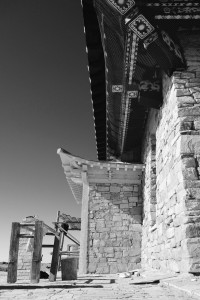Photographs are reprinted here with permission of the Zava Damdin Institute of Mongolia.

Delgeruun Choira, Delgerstogt Sum in Dundgovi Aimag Mongolia. Since (re)construction of the destroyed precinct began onsite in 2004, three main (yet architecturally quite different) structures designed by Zava Damdin and his local associates have emerged: (a) The Joyful Temple of Manjushri (centre-lower left); (b) The Golden Temple (centre-upper); and (c) The Majestic Shining White Palace ger (centre-lower right). September 2015. Photo: C.Pleteshner
The Golden Temple: a contemporary envisioning of Mongol Gelugpa Buddhist architecture in the Gobi Desert (under construction)
The hand-laid local Gobi stone masonry is an important architectural feature of Delgeruun Choira’s Golden Temple, both inside (see below) and out (see above). Construction is carried out during the relatively warmer months. During the Winter, when the temperature regularly falls below -20 degrees C, it is just too cold to continue construction work. However, lams continue to study and be in residence all year round.
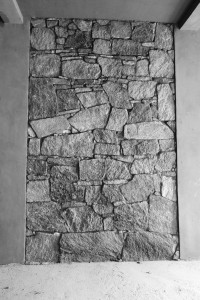
The Golden Temple internal stone masonry – a visual/textural feature constructed from local Gobi stone. Delgeruun Choira September 2015. Photo: C Pleteshner
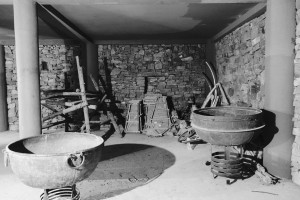
The interior of the Golden Temple (under construction) has many visually-striking counterpoints. Ancient Gobi rock walls frame two Mongol ‘Тогоо’ (the copper vats once used at the monastery to brew drinks such as tea). Modernity’s presence is also felt, through the use of reinforced concrete, plate glass, electricity and modern engineering techniques. I am at a loss as to how to describe locally-made Mongolian scaffolding other than to say it has a creative resonance born from the necessity to ‘make-do’ in such a remote locale. Delgeruun Choira September 2015. Photo: C Pleteshner
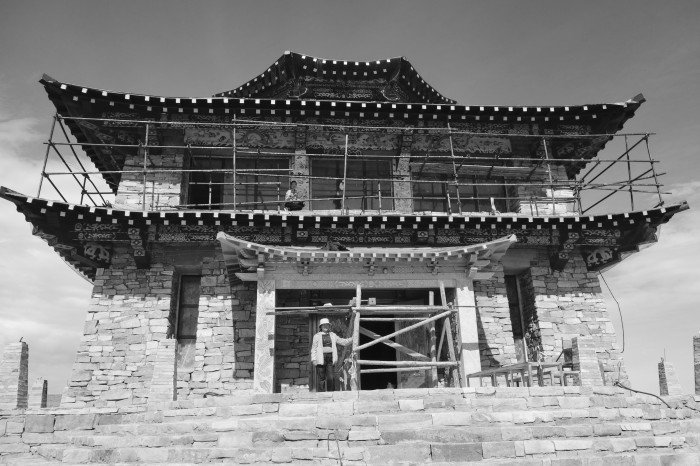
The imposing facade of The Golden Temple is replete with architectural and artistic features. In this post, I have chosen to foreground two of these. In addition to the grounded earthiness of its stone walls, dragon and other motifs are now being painted or etched into the external facia. Two Mongolian artists, B.Enerel (upper level, seated) and S. Gantsatstral ( ground level, standing) lived at Delgeruun Choira for 2 months (Aug.-Sept.) in the Summer of 2015. During that time, each completed a different substantive work anchored in a dragon motif (see below). Delgeruun Choira September 2015. Photo: C.Pleteshner
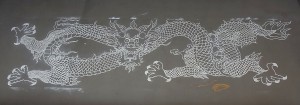
Designed by Zava Damdin, this is an example of one of the many distinct and recurring dragon forms etched into the external facia of The Golden Temple. This particular five-clawed dragon has been etched into the concrete facia above the South-facing main entrance door on the ground floor. September 2015. Photo: C.Pleteshner
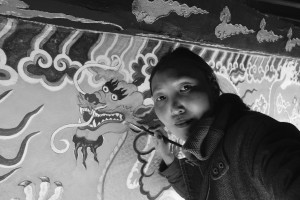
Only the highest quality oil paints (‘Master Class’ from Russia and ‘Rembrandt’ from The Netherlands) were used by the artists to paint the elaborate dragon panels on the first-floor level of the The Golden Temple (see above) as well as the ground-level front doors of the Joyful Temple of Manjushri (see below). Enerel is to be congratulated, for it is she who, over a period of two months, painted the dragon panels on The Golden Temple’s South-facing first floor wall (see above). Delgeruun Choira, September 2015. Photo (selfie): B.Enerel
Delgeruun Choira: The Joyful Temple of Manjushri (reconstruction completed in 2004-5)
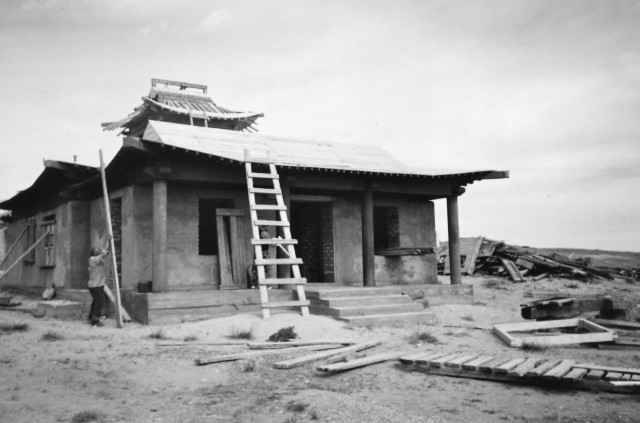
In 2004, after fourteen years studying and teaching at Amarbaysgalant Monastery in Selenge Aimag, Zava Damdin Bagsh relocated to Delgeruun Choira in the Gobi. Rebuilding the rased infrastructure was of the highest priority on arrival. The structure now know as ‘The Joyful Temple of Manjushri’ was the first and only existing temple to be rebuilt. Delgeruun Choira, August 2004. Photo: C.Pleteshner
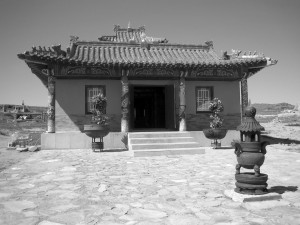
The rebuilding of The Joyful Temple of Manjushri started with Zava Bagsh’s arrival at Delgeruun Choira in April 2004. I took this photograph on the day of its completion in August 2005. It was also the sunny morning of the day that the very first Gongor Bumba Puja would be conducted at Delgeruun Choira since 1937 (est.) when all such ritual performances became prohibited under Soviet socialist decree. The Dundgovi steppe is a long way from the ‘metropol’ therefor it is not known whether such ceremonies continued, albeit unofficially, in the local Delgertsogt area after 1937 or not. Photo: C.Pleteshner
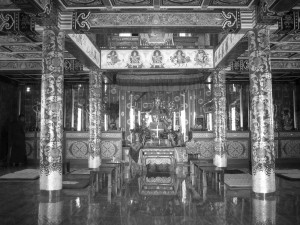
The exquisite and elaborate rebuilt interior of the main hall of The Joyful Temple of Manjushri at Delgeruun Choira just after its completion in August 2005. All other new major structures at DC, whilst drawing from well-established ‘traditional’ architectural forms, are not restorations, but rather innovative new structures in design. Photo: C.Pleteshner
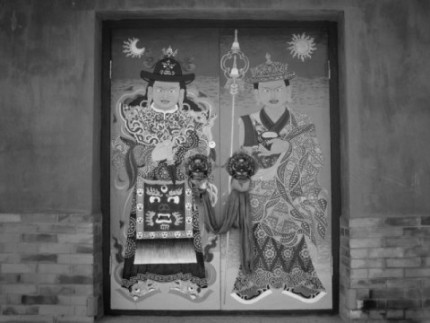
In 2005, the South-facing main entrance doors to The Joyful Temple of Manjushri were originally painted by the artist D.Baatbaatar at the request of Zava Damdin. They depict two attendants of Sitapa, one of Zava Damdin’s lineage protectors. August 2005. Photo: C.Pleteshner
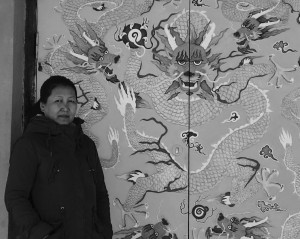
After a decade of exposure to the Gobi’s weather extremes (heat, cold and wind) the entrance doors to The Joyful Temple of Manjushri needed to first be repaired, and then repainted. The Mongolian artist S.Gantsatstral repainted the doors with a design based on the dragon motif. Once painted, she then sealed the newly painted doors with multiple coats of clear lacquer to protect the doors from the harsh weather in the years to come. Delgeruun Choira September 2015. Photo: B.Enerel
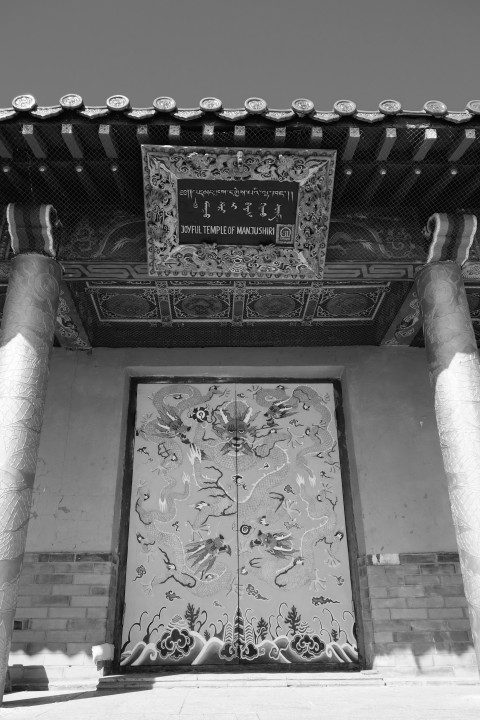
The main entrance to The Joyful Temple of Manjushri at Delgeruun Choira. Five dragons, each representing one of the Five Dhyani Buddhas (or one of the Five Wisdom Tathagatas [Chinese: 五智如来; pinyin: Wǔzhì Rúlái]) of the Vajrayana Buddhist pantheon, now decorate the main doors to the entrance way. September 2015. Photo: C.Pleteshner
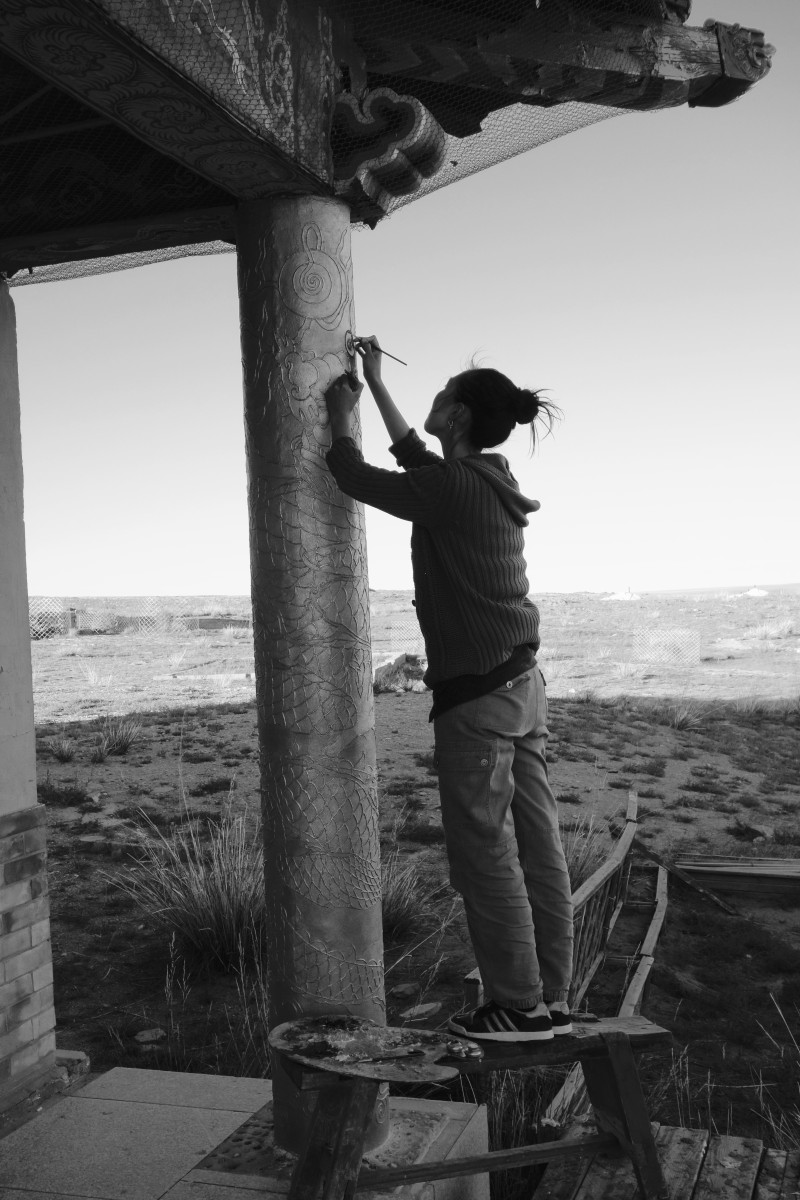
At Zava Damdin Lama’s request, the very last thing to be done by Enerel and Gantsastral to seal their two month-long dragon painting projects, was for them to paint in the eyes of each dragon etched into the four front columns of The Joyful Temple of Manjushri. Here, Enerel is seen doing this final and very important symbolic task. Delgeruun Choira, September 2015. Photo: C.Pleteshner
For more information about these two Mongolian artists see: Vignette 02: Gantsatstral and Vignette 03:Enerel
Attribution
In keeping with ethical scholarly research and publishing practices and the Creative Commons Attribution 4.0 International License, I anticipate that anyone replicating the photographs or translating into another language all or part of this article and submitting it for accreditation or other purpose under their own name, to acknowledge this URL and its author as the source. Not to do so, is contrary to the ethical principles of the Creative Commons license as it applies to the public domain.
end of transcript.
Refer to the INDEX for other articles that may be of interest.
© 2013-2025. CP in Mongolia. This post is licensed under the Creative Commons Attribution 4.0 International License. Documents linked from this page may be subject to other restrictions. Posted: 6 October 2015. Last updated: 29 October 2017.
